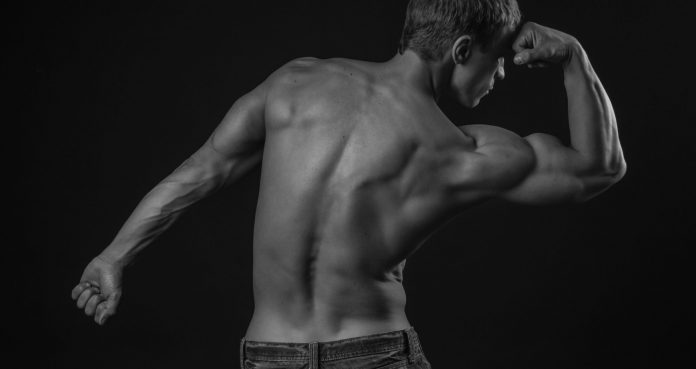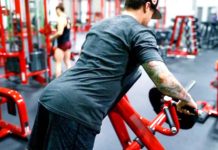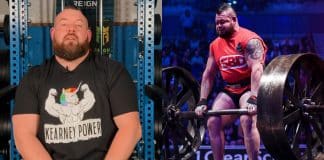
The Ultimate Exercise For Building The Back
There are a number of popular resistance exercises that are used to develop the major muscles of the back such as the lats, rhomboids, and traps.
Regardless of your level of experience, the inverted row is an exercise that can prove to be highly beneficial for building the back.
This article will firstly detail how to perform the inverted row and then discuss a number of the benefits that are associated with the exercise.
Finally, the article will provide a number of inverted row variations and alternatives that can be used to align with your needs, limitations, and goals.
How to Perform the Inverted Row
While the inverted row is relatively straightforward in set-up and execution, it is worthwhile running through the below steps to ensure that you are performing the movement safely and effectively.
Step One: The exercise will be completed using a squat rack or Smith’s machine and the first step is to adjust the bar height.
When under the bar, ensure that it is slightly lower than the pecs to optimize lat development. For trap development, align the bar over the middle of the pecs.
Step Two: Grasp the bar using a grip that is similar to a conventional barbell row. This means using an overhand grip and placing the hands slightly wider than shoulder-width.
Keep the legs extended away from the body and avoid letting the hips drop – the body should be held long.
Step Three: Before initiating the row, pull the shoulders back and down, drive the chest up, and engage the core muscles.
Row the chest towards the bar by squeezing between the shoulder blades and bending at the elbows.
Step Four: Once the chest has risen to the bar, emphasize the squeeze between the shoulder blades before reversing the movement in a controlled fashion.
Inverted Row Benefits
As mentioned, the inverted row can serve as an effective exercise for every lifter, regardless of their level of experience.
With that being said, there are specific benefits that a beginner lifter may experience with the inverted row that differ from the benefits experienced by an advanced lifter.
Beginner Inverted Row Benefits
1) Foundational Strength Exercise
The inverted row has been found to highly activate a number of major muscles found in the back, shoulders, and arms (1).
Therefore, the inverted is a superb exercise and allows the beginner to effectively build strength in the upper body.
2) Highly Adaptable
One of the best things about the inverted row is that it can be easily adapted to increase or reduce the demand on the back.
For example, by bringing the feet further away, the body becomes more parallel to the floor. This, in turn, increases the range of motion of the row thus increasing the demand.
3) Improving Technique and Movement
When it comes to strength training for beginners, the focus should initially be on improving movement efficiency.
A combination of building a base level of strength and enhancing technique can allow the lifter to then progress onto more challenging back-based exercises such as the barbell bent row.
Intermediate / Advanced Inverted Row Benefits
1) Increasing Training Volume
While more challenging exercises will likely be prioritized for the intermediate or advanced lifter, the inverted row can be effectively used to increase training volume.
Research has highlighted that a high training volume is best for enhancing the rate of growth (2) and therefore, using the inverted row as an accessory exercise can prove to be beneficial for back hypertrophy.
2) Less Taxing on Joints
While heavy rowing exercises are beneficial for accelerating the rate of strength development, they can be highly taxing on the shoulder and elbow joints.
Considering that the conventional inverted row uses only bodyweight, it will reduce the amount of stress that these joints experience while still effectively working the back muscles.
3) Improving Muscle Activation
The inverted row provides a great opportunity to develop muscle activation. As highlighted, the inverted row can be easily manipulated to increase the demand or develop specific characteristics.
By focusing on time under tension through the use of eccentric and tempo sets, you can effectively improve back and shoulder muscle activation (3).
Inverted Row Progressions and Alternatives
This section will detail a number of progressions and alternatives that can be used to increase or reduce the demand of the inverted row.
Inverted Row Progressions
1) Tempo Inverted Row
The tempo variation is excellent for improving time under tension and muscle contractility. The method very simply involves manipulating the tempo of each contraction.
A common tempo method is the “3112” which involves a three-second lowering phase, one-second hold at the bottom, one-second lifting phase, and a two-second hold at the top.
2) Feet Elevated / Weighted Inverted Row
For those who are looking to increase the intensity of the inverted row, consider elevating the feet and / or add weight.
For these progressions, simply place the feet on a bench or box and position a weight plate on the chest before performing a set of rows.
Inverted Row Alternatives
1) Knee Bent Inverted Row
As the name suggests, for this variation, instead of keeping the legs entirely straight, bend both knees to 90 degrees.
This seemingly small alteration will change the dynamic of the movement, reduce the range of motion, increase stability and place the body in a more mechanically advantageous position.
2) TRX Inverted Row
The TRX is a highly functional bodyweight trainer. If you do not have access to the squat rack or Smith’s machine, the TRX can step in.
While holding onto both handles, walk the feet forward so that you lean backward and replicate the position of the inverted row. From there, perform a standard set of rows.
3) Chest Supported Row
The chest supported is an excellent alternative that will effectively target the back and shoulder muscles while providing spinal stability.
For this, set a bench of a slight incline and lie directly on top of it. Reach down, grasp the weight and perform a rowing action.
Final Word
The inverted row is a simple yet highly effective bodyweight exercise that can lead to substantial improvements in back strength, size, and contractility. While it is especially useful for the beginner, the inverted row can also be highly valuable for the advanced lifter.
Let us know what you think in the comments below. Also, be sure to follow Generation Iron on Facebook, Twitter, and Instagram.
*Images courtesy of Envato
References
1 – Youdas, James W.; Keith, Julianne M.; Nonn, Danielle E.; Squires, Adam C.; Hollman, John H. (2016-07). “Activation of Spinal Stabilizers and Shoulder Complex Muscles During an Inverted Row Using a Portable Pull-up Device and Body Weight Resistance”. Journal of Strength and Conditioning Research. 30 (7): 1933–1941. doi:10.1519/JSC.0000000000001210. ISSN 1533-4287. PMID 26422610.
2 -SCHOENFELD, BRAD J.; CONTRERAS, BRET; KRIEGER, JAMES; GRGIC, JOZO; DELCASTILLO, KENNETH; BELLIARD, RAMON; ALTO, ANDREW (2019-1). “Resistance Training Volume Enhances Muscle Hypertrophy but Not Strength in Trained Men”. Medicine and Science in Sports and Exercise. 51 (1): 94–103. doi:10.1249/MSS.0000000000001764. ISSN 0195-9131. PMC 6303131. PMID 30153194.
3 – Burd, Nicholas A; Andrews, Richard J; West, Daniel WD; Little, Jonathan P; Cochran, Andrew JR; Hector, Amy J; Cashaback, Joshua GA; Gibala, Martin J; Potvin, James R; Baker, Steven K; Phillips, Stuart M (2012-01-15). “Muscle time under tension during resistance exercise stimulates differential muscle protein sub-fractional synthetic responses in men”. The Journal of Physiology. 590 (Pt 2): 351–362. doi:10.1113/jphysiol.2011.221200. ISSN 0022-3751. PMC 3285070. PMID 22106173.


















